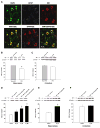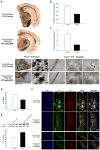17β-Estradiol regulates insulin-degrading enzyme expression via an ERβ/PI3-K pathway in hippocampus: relevance to Alzheimer's prevention
- PMID: 20053478
- PMCID: PMC2889185
- DOI: 10.1016/j.neurobiolaging.2009.12.010
17β-Estradiol regulates insulin-degrading enzyme expression via an ERβ/PI3-K pathway in hippocampus: relevance to Alzheimer's prevention
Abstract
Insulin-degrading enzyme (IDE), an enzyme that primarily degrades insulin, has recently been demonstrated to play a significant role in the catabolism of amyloid β (Aβ) protein in the brain. Reduced IDE expression and/or activity have been associated with the etiology and development of Alzheimer's disease (AD). Using three model systems, the present investigation provides the first documentation indicating that estrogen robustly regulates the expression of IDE in normal, menopausal and early-stage AD brains. In vitro analyses in primary cultures of rat hippocampal neurons revealed that 17β-estradiol (17β-E2) increased IDE in both mRNA and protein levels in a time-dependent manner. Further pharmacological analyses indicated that 17β-E2-induced IDE expression was dependent upon estrogen receptor (ER) β and required activation of phosphatidylinositol 3-kinase (PI3-K). In vivo analyses in adult female rats revealed a brain region-specific responsive profile. Ovariectomy (OVX) induced a significant decline in IDE expression in the hippocampus, which was prevented by 17β-E2. Neither OVX nor 17β-E2 affected IDE expression in the cerebellum. In vivo analyses in triple transgenic AD (3xTg-AD) female mice revealed an inverse correlation between the age-related increase in Aβ load and the decrease in IDE expression in the hippocampal formation. Treatment with 17β-E2 attenuated Aβ accumulation/plaque formation and elevated hippocampal IDE expression in 12-month-old 3xTg-AD OVX mice. Collectively, these findings indicate that 17β-E2 regulates IDE expression in a brain region-specific manner and such a regulatory role in the hippocampus, mediated by an ERβ/PI3-K pathway, could serve as a direct mechanism underlying estrogen-mediated preventative effect against AD when initiated at the onset of menopause.
Copyright © 2009 Elsevier Inc. All rights reserved.
Conflict of interest statement
The authors have no conflicts of interest to disclose. The use of animals was approved by the Institutional Animal Care and Use Committee at the University of Southern California.
Figures




References
-
- Authier F, Posner BI, Bergeron JJ. Insulin-degrading enzyme. Clin Invest Med. 1996;19:149–160. - PubMed
-
- Bernstein HG, Ansorge S, Riederer P, Reiser M, Frolich L, Bogerts B. Insulin-degrading enzyme in the Alzheimer’s disease brain: prominent localization in neurons and senile plaques. Neurosci Lett. 1999;263:161–164. - PubMed
-
- Bertram L, Blacker D, Mullin K, Keeney D, Jones J, Basu S, Yhu S, McInnis MG, Go RC, Vekrellis K, Selkoe DJ, Saunders AJ, Tanzi RE. Evidence for genetic linkage of Alzheimer’s disease to chromosome 10q. Science. 2000;290:2302–2303. - PubMed
-
- Bian L, Yang JD, Guo TW, Sun Y, Duan SW, Chen WY, Pan YX, Feng GY, He L. Insulin-degrading enzyme and Alzheimer disease: a genetic association study in the Han Chinese. Neurology. 2004;63:241–245. - PubMed
-
- Bjork BF, Katzov H, Kehoe P, Fratiglioni L, Winblad B, Prince JA, Graff C. Positive association between risk for late-onset Alzheimer disease and genetic variation in IDE. Neurobiol Aging. 2007;28:1374–1380. - PubMed
Publication types
MeSH terms
Substances
Grants and funding
LinkOut - more resources
Full Text Sources
Other Literature Sources
Medical
Molecular Biology Databases

